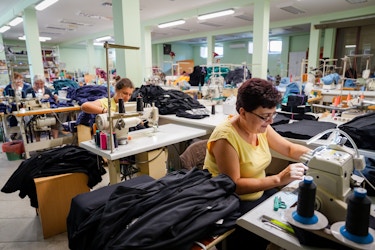Onshoring typically refers to companies that haven’t yet set up an overseas operation. Whether it’s a startup or an expanding business, these companies can elect to set up production domestically.
Reshoring is often used interchangeably with onshoring, but with a small nuance.
“Reshoring applies to businesses that already have manufacturing operations overseas and are in the process of transferring production back to their domestic nation,” wrote Thomasnet.
What are the benefits of onshoring?
There are several compelling reasons to explore your options for manufacturing within the United States.
“The benefits of these strategies are many—lower transportation expenses, reduced import/export requirements and costs, increased quality control, faster response times, and improved local business relationships—but the most pressing are risk mitigation and greater sustainability,” wrote Kathleen Abbott in Forbes.
Companies that have their manufacturing operations located within the same country gain better visibility into their supply chain. Keeping production within the same geography mitigates risk. If several of your components are manufactured in different countries, you run the risk of your assembly line collapsing completely if just one of those countries has a natural disaster.
“Shorter shipping routes may mean fewer logistical complications, while a local workforce producing components in local factories may lead to greater inventory stability,” wrote Abbott.
It’s also more environmentally friendly to keep your supply chain local. Your products won’t need to travel across oceans, shrinking your carbon footprint and your transportation costs. It can help your brand reputation and marketing to manufacture in the United States too.
[Read more: How to Find a Factory to Manufacture Your Product]
What are the drawbacks of onshoring?
Onshoring can be expensive, and for some products, it may be impossible. Onshoring tends to cost more, not just in terms of higher labor costs and overhead. Setting up onshoring can be an expensive proposition.
“If the effort is poorly managed, or if the circumstances are not conducive to a smooth transition, reshoring efforts can fail. Often, a company underestimates the costs and the logistical planning involved,” wrote Investopedia.
“While reshoring is a way to stimulate the domestic economy, it is important for companies to remember that some products are best left offshore, particularly those native to other countries,” Investopedia stated.
Plus, for onshoring to work, there must be an affordable and available labor force. Currently, just over 8% of Americans work in manufacturing. Manufacturing makes up a very small portion of the economy. And compared to other markets, domestic wages and the cost of living make it impossibly expensive for small business owners to relocate their production operations in the U.S.
Should you onshore?
As you weigh your options, there are a few questions that can help you better evaluate whether onshoring is the right path for your company. Ask yourself:
- Are there incentives available to onshore in my specific industry?
- Are materials readily available locally? (If no, then you’ll still have to import some goods from overseas, which may negate the point of onshoring.)
- Are there enough skilled people available to manage my production operations?
- Will onshoring ultimately lead to reduced costs over the long term?
Start to explore your options with the U.S. Small Business Administration’s new portal, the Make Onshoring Great Again portal.
[Read more: Small Business Briefing on Tariffs: Expert Insights & Latest News]
CO— aims to bring you inspiration from leading respected experts. However, before making any business decision, you should consult a professional who can advise you based on your individual situation.







